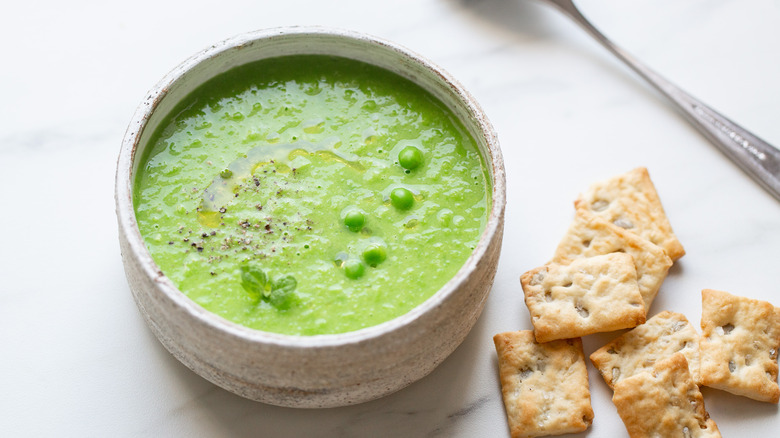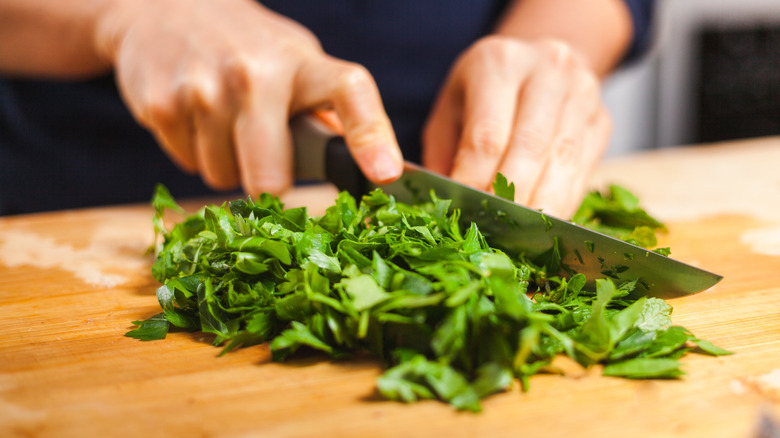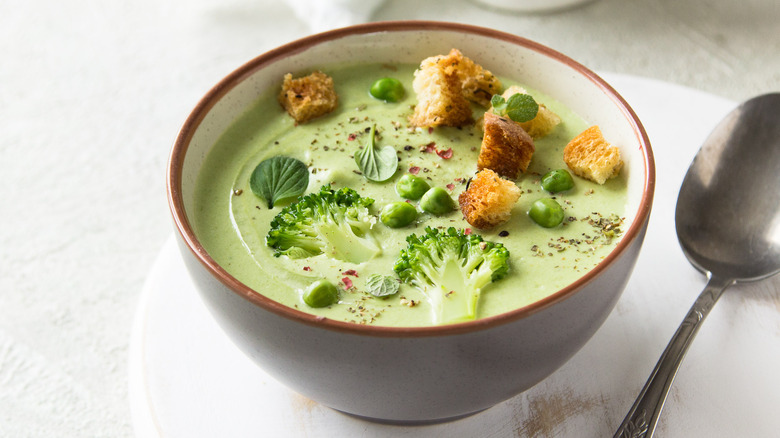Your Pea Soup Is Seriously Missing One Essential Herb
From cold-curing chicken noodle to springy tomato basil, steaming bowls of soup are comforting, easy-to-make, one-pot dishes enjoyed in many different forms across many different cultures. Beyond their simplicity and warming essence, one of the most appealing aspects of soup is that it's customizable. Whether you're a vegan swapping chicken stock for veggie broth or satisfying your sweet tooth with a dash of cinnamon in your favorite chili soup, there's one essential modification you should make to a classic English pea soup: add mint.
The cooling, menthol sensation of mint uplifts the earthy flavor profile of peas while adding a jazzy edge to their subtle sweetness for more complex spoonfuls. While an herb-free pea soup boasts a classic vegetal taste, especially when prepared with other classic pea soup provisions like carrots and onion, mint gives it a refreshing edge, making it the perfect spring or summer iteration of this classic legume soup.
But it's not just the flavor of pea soup that benefits from a touch of mint; it's also the nutritional profile of the dish. While peas are rich in both fiber and protein, mint aids in digestion, ensuring that everything goes down stomach ache-free and leaves you both satisfied and fortified.
Tips for introducing mint to pea soup
Adding mint to pea soup is one of the easiest parts of crafting the dish. But even working with minty garnishes can be tricky, so keep a few tips in mind when introducing this uplifting herb to your protein-packed green soup.
First, determine how you want to integrate mint into your pea soup. Whole mint leaves added to the top of the soup will serve as a visually appealing garnish with a milder flavor compared to other methods, offering occasional bursts of minty freshness and a pleasant but subtle aroma. By adding finely chopped mint leaves to pea soup, you'll get an evenly distributed and prominent mint flavor in each spoonful. Another option is to infuse and strain your veggie or bone broth with mint before introducing it to the soup to avoid any leafy textures in your bowl. Similarly, you can add mint extract to the soup if you're not a fan of fresh herb-dotted pea soup.
Do you want to maximize the mint flavor in your pea soup? Consider "bruising" the leaves before incorporating them into the pot. You can bruise herbs like mint by bending and rolling them to create a damp crease or fault line in the leaf. By doing this, you're breaking the plant cells open and activating the oils inside them for a bolder flavor and aroma.
Complementary ingredients for minty pea soup
There's no denying that minty pea soup is delicious on its own. However, if you're a flavor fanatic looking for complementary ingredients to add to the soup or enjoy on the side, there are plenty to choose from. Feeling herbaceous? Introduce complementary herbs to the mint-kissed pea soup to bolster its garden-fresh bravado. Basil's peppery sweetness can curb the intense menthol kick of mint, while cilantro's citrusy notes will bolster its brightness.
Make the soup a side pairing alongside a lean protein, like grilled chicken, where the mild taste of the meat allows the mint-infused pea soup to shine while its delicate, crusty char brings a subtle smokiness that enhances the overall depth of the meal. Vegans — we see you! Pair your minty pea soup with sautéed mushrooms for a rich, umami-forward edge that complements the sweetness of peas and the sharp taste of mint. Of course, you can never go wrong with crunchy slices of bread or croutons for soaking up the flavors of the soup while adding a textural contrast to its creamy smoothness.
From mint chocolate chip ice cream to mint pesto, there are a million and one ways to use this vibrant herb. However, one of the tastiest and most satisfying ways to put mint to use is by bringing it into your favorite pea soup recipe.


